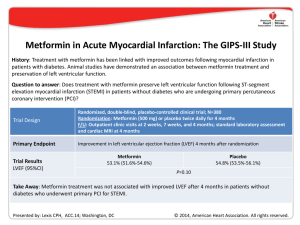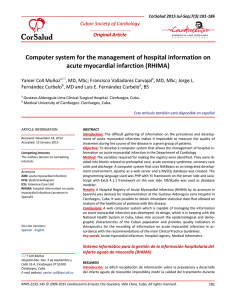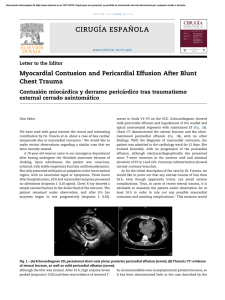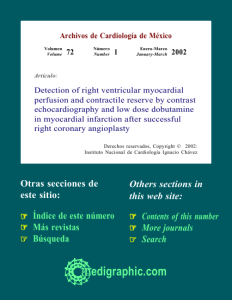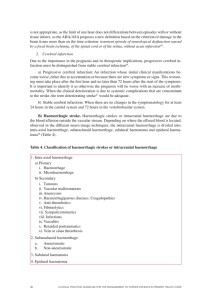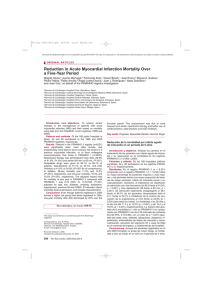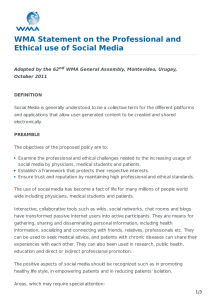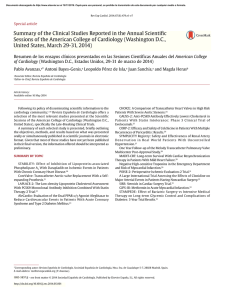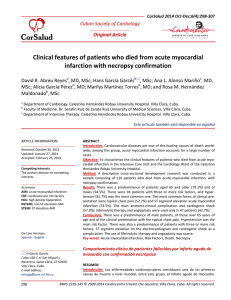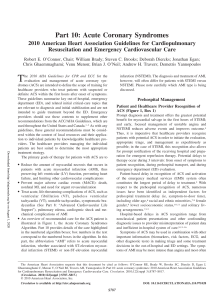Prognostic Value of a Comprehensive Cardiac
Anuncio
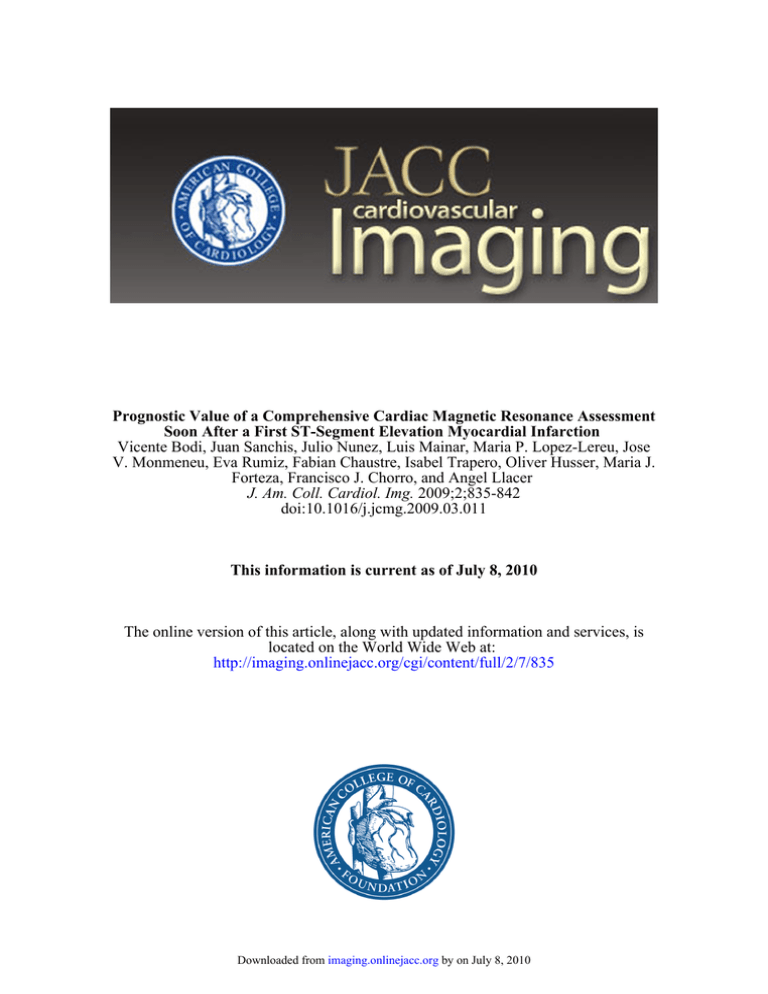
Prognostic Value of a Comprehensive Cardiac Magnetic Resonance Assessment Soon After a First ST-Segment Elevation Myocardial Infarction Vicente Bodi, Juan Sanchis, Julio Nunez, Luis Mainar, Maria P. Lopez-Lereu, Jose V. Monmeneu, Eva Rumiz, Fabian Chaustre, Isabel Trapero, Oliver Husser, Maria J. Forteza, Francisco J. Chorro, and Angel Llacer J. Am. Coll. Cardiol. Img. 2009;2;835-842 doi:10.1016/j.jcmg.2009.03.011 This information is current as of July 8, 2010 The online version of this article, along with updated information and services, is located on the World Wide Web at: http://imaging.onlinejacc.org/cgi/content/full/2/7/835 Downloaded from imaging.onlinejacc.org by on July 8, 2010 JACC: CARDIOVASCULAR IMAGING VOL. 2, NO. 7, 2009 © 2009 BY THE AMERICAN COLLEGE OF CARDIOLOGY FOUNDATION PUBLISHED BY ELSEVIER INC. ISSN 1936-878X/09/$36.00 DOI:10.1016/j.jcmg.2009.03.011 Prognostic Value of a Comprehensive Cardiac Magnetic Resonance Assessment Soon After a First ST-Segment Elevation Myocardial Infarction Vicente Bodi, MD,* Juan Sanchis, MD,* Julio Nunez, MD,* Luis Mainar, MD,* Maria P. Lopez-Lereu, MD,† Jose V. Monmeneu, MD,† Eva Rumiz, MD,* Fabian Chaustre,* Isabel Trapero,* Oliver Husser, MD,* Maria J. Forteza,* Francisco J. Chorro, MD,* Angel Llacer, MD* Valencia, Spain O B J E C T I V E S To evaluate the prognostic value of a comprehensive cardiac magnetic resonance (CMR) assessment soon after a first ST-segment elevation myocardial infarction (STEMI). B A C K G R O U N D CMR allows for a simultaneous assessment of wall motion abnormalities (WMA), WMA with low-dose dobutamine (WMA-dobutamine), microvascular obstruction, and transmural necrosis. This approach has been proven to be useful to predict late systolic recovery soon after STEMI. Its prognostic value and the relative prognostic weight of these indexes are not well-defined. M E T H O D S We studied 214 consecutive patients with a first STEMI treated with thrombolytic therapy or primary angioplasty discharged from hospital. In the first week (7 ⫾ 1 day after infarction), with CMR we determined the extent (number of segments) of WMA, WMA-dobutamine, microvascular obstruction, and transmural necrosis. R E S U L T S During a median follow-up of 553 days, 21 major adverse cardiac events (MACE) including 4 cardiac deaths, 6 nonfatal myocardial infarctions, and 11 readmissions for heart failure were documented. The MACE was associated with a larger extent of WMA (8 ⫾ 4 segments vs. 5 ⫾ 3 segments, p ⬍ 0.001), WMA-dobutamine (6 ⫾ 4 segments vs. 4 ⫾ 3 segments, p ⫽ 0.004), microvascular obstruction (3 ⫾ 3 segments vs. 1 ⫾ 2 segments p ⬍0.001), and transmural necrosis (7 ⫾ 3 segments vs. 3 ⫾ 3 segments, p ⬍ 0.001). In a complete multivariate analysis that included baseline characteristics, electrocardiogram, biomarkers, angiography, ejection fraction, left ventricular volumes, and all CMR indexes, WMA/segment (hazard ratio: 1.29 [95% confidence interval: 1.11 to 1.49], p ⫽ 0.001) and the extent of transmural necrosis/segment (hazard ratio: 1.30 [95% confidence interval: 1.12 to 1.51], p ⬍ 0.001) were the only independent prognostic variables. C O N C L U S I O N S A comprehensive CMR assessment is useful for stratifying risk soon after STEMI, but only the extent of systolic dysfunction and of transmural necrosis provide independent prognostic information. (J Am Coll Cardiol Img 2009;2:835– 42) © 2009 by the American College of Cardiology Foundation From the *Cardiology Department, Hospital Clinico Universitario, Universidad de Valencia, Valencia, Spain; and the †Cardiovascular Magnetic Resonance Imaging Unit, ERESA, Valencia, Spain. This study was supported by the Spanish Government (PI08128 and HERACLES grants). Manuscript received November 17, 2008; revised manuscript received February 26, 2009, accepted March 9, 2009. Downloaded from imaging.onlinejacc.org by on July 8, 2010 836 Bodi et al. CMR and Prognosis After Infarction JACC: CARDIOVASCULAR IMAGING, VOL. 2, NO. 7, 2009 JULY 2009:835– 42 I n patients with ST-segment elevation myocardial infarction (STEMI) discharged from hospital, risk stratification is a challenge (1). Noninvasive techniques are necessary not only to establish the probability of systolic recovery (2) but also to predict risk (3). See page 843 Soon after STEMI, cardiac magnetic resonance (CMR) allows for a simultaneous state-of-the-art analysis of the extent of wall motion abnormalities (WMA) at baseline, WMA with low-dose dobutamine (WMA-dobutamine), microvascular obstruction and transmural necrosis (2,4). Separately, some of these CMR indexes have been proven to be useful for stratifying risk (5– 8), but their relative prognostic weight once adjusted for well-established predictors is unknown. ABBREVIATIONS Taking into account that this is a timeAND ACRONYMS consuming approach and that CMR is not CI ⴝ confidence interval widely available yet, this issue needs to be CMR ⴝ cardiac magnetic addressed. resonance The management and risk stratification ECG ⴝ electrocardiogram of patients with STEMI has to be based HR ⴝ hazard ratio on a complete clinical evaluation and MACE ⴝ major adverse cardiac on an estimation of systolic function (1). events We hypothesized that a comprehensive STEMI ⴝ ST-segment elevation assessment of CMR soon after STEMI myocardial infarction can provide independent prognostic inTIMI ⴝ Thrombolysis In formation beyond this traditional and Myocardial Infarction well-established approach. The relative WMA ⴝ wall motion value of CMR indexes for predicting outabnormalities come soon after a first STEMI was also WMA-dobutamine ⴝ WMA with low-dose dobutamine analyzed. METHODS Study group. From January 2004 to December 2006, we prospectively included 250 consecutive patients admitted to a tertiary university hospital with a first STEMI treated with thrombolytic therapy or primary angioplasty. The exclusion criteria were as follows: contraindications to CMR (n ⫽ 3), death (n ⫽ 14), reinfarction (n ⫽ 5), severe clinical instability (n ⫽ 11), and need for cardiac surgery during admission (n ⫽ 3). Accordingly, the study group comprised 214 patients without serious complications during admission, discharged from hospital, and in whom CMR studies were successfully performed. The local ethics committee approved the research protocol. Informed consent was obtained from all subjects. Reperfusion therapy. Reperfusion strategy and medical treatment were left to the discretion of the attending cardiologists. Thrombolytic agents were administered in 125 patients (58%), and 89 (42%) were directly submitted to percutaneous revascularization. Overall, 198 patients (92%) were treated with a stent: 89 during primary angioplasty, 23 during rescue angioplasty, and 86 during routine cardiac catheterization performed after thrombolysis (median 2 days). Thrombolysis In Myocardial Infarction (TIMI) flow grade and myocardial blush grade were determined offline by an experienced observer unaware of CMR results with the software Integris HM3000 (Philips, Best, the Netherlands). A TIMI flow grade 3 and myocardial blush grade 2 to 3 were regarded as normal (9). Baseline characteristics, electrocardiogram, and blood samples. Baseline characteristics and clinical data were recorded in all cases. The TIMI risk score for STEMI was calculated in all patients as a surrogate of baseline clinical risk (10). The percentage of sum ST-segment resolution 90 min after reperfusion therapy was determined. Peak troponin I was assessed. CMR. CMR (1.5-T scanner, Sonata Magnetom, Siemens, Erlangen, Germany) was performed 7 ⫾ 1 day (at least 48 h after cardiac catheterization) after STEMI in accordance with our laboratory protocol (2,8,11). All images were acquired by a phasedarray body surface coil during breath-holds and were electrocardiogram (ECG)-triggered. Cine images were acquired at rest and during intravenous infusion of low-dose (10 g/kg/min) dobutamine in 2-, 3-, and 4-chamber views and every 1 cm in short-axis views with steady-state free precession imaging sequences (repetition time/echo time: 3.2/1.6 ms; flip angle: 61°; matrix: 256 ⫻ 128; slice thickness: 6 mm; temporal resolution: 26 ms). Delayed enhancement imaging was performed in the same projections used for cine images at least 10 min after administering 0.1 mmol/kg of gadoliniumdiethylenetriaminepentaacetic acid (Magnograf, Juste S.A.Q.F., Madrid, Spain). A segmented inversion recovery steady-state free precession imaging sequence was used (repetition time/echo time: 2.5/1.1 ms; slice thickness: 6 mm; flip angle: 50°; matrix: 195 ⫻ 192) nullifying myocardial signal. CMR data analysis. The CMR studies were analyzed offline by an experienced observer blinded to all patient data with customized software (QMASS Downloaded from imaging.onlinejacc.org by on July 8, 2010 Bodi et al. CMR and Prognosis After Infarction JACC: CARDIOVASCULAR IMAGING, VOL. 2, NO. 7, 2009 JULY 2009:835– 42 Figure 1. Cardiac Magnetic Resonance Indexes Analyzed Example of a patient with a large anterior myocardial infarction. (Left) Abnormal wall motion at rest in the apical area (arrow). (Middle) Significant improvement with low-dose dobutamine (arrow) in the same area. (Right) Microvascular obstruction in the core of a large area of necrosis in the mid ventricular area (arrow). WMA ⫽ wall motion abnormalities. MR 6.1.5, Medis, Leiden, the Netherlands). The 17-segment model was applied (12). End-diastolic volume index (ml/m2), endsystolic volume index (ml/m2), ejection fraction (%), ejection fraction with low-dose dobutamine (%), and left ventricular mass (g/m2) were quantified by manual definition of endocardial and epicardial borders of all short-axis slices in cine images. Four CMR indexes were determined (Fig. 1). The criteria used to define abnormal results on a segmental basis were based on validated definitions (4,7,13) and on our previous data to predict late systolic recovery (2,14). On a patient basis, the extent of each index was defined as the number of segments displaying abnormal results (4,8,14). The cutoff values used to consider “significant” abnormalities were established on the basis of the receiver-operating characteristics curves for predicting major adverse cardiac events (MACE). WMA. On a segmental basis wall thickening was quantitatively assessed in all segments in cine sequences at rest and abnormal wall thickening (endsystolic thickness ⫺ end-diastolic thickness, mm) was considered if ⱕ2 mm. On a patient basis, significant WMA was considered if abnormal wallthickening was present in ⬎5 segments. WMA-DOBUTAMINE. On a segmental basis abnormal wall thickening was considered if ⱕ2 mm. On a patient basis, significant WMA-dobutamine was considered if abnormal wall thickening was present in ⬎5 segments. On a segmental basis this index was visually defined in delayed enhancement sequences as a lack of contrast uptake MICROVASCULAR OBSTRUCTION. in the core of a segment surrounded by tissue showing delayed enhancement. On a patient basis, significant microvascular obstruction was considered if it was detected in at least 1 segment. On a segmental basis, transmural necrosis was quantitatively considered when ⱖ50% of the myocardial wall showed signal intensity ⬎2 SD in comparison with a remote noninfarcted area. On a patient basis, significant extent of transmural necrosis was considered if it was detected in ⬎4 segments. The percentage of left ventricular mass showing delayed enhancement was also calculated and used as a surrogate of infarct size. In our laboratory, in a series of 50 patients (850 segments) with STEMI, the interobserver variability with respect to all indexes evaluated was ⬍5%. End point and follow-up. The end point was MACE and included cardiac death, admission for nonfatal myocardial infarction (15), and admission for heart failure (16) whichever occurred first. All MACE were reviewed, and consensus between 3 cardiologists was required to finally designate a MACE. Statistical analysis. Continuous data were expressed as the mean ⫾ SD and were compared by the unpaired t test. Proportions were compared by the chi-square statistic; the Fisher exact test was used when appropriate. Survival distributions for the time to event were estimated with the KaplanMeier method and the log-rank test. The association of variables with MACE was assessed with the Cox proportional hazard regression model with stepwise multivariate procedures. Variables with a p value ⱕ0.2 in the univariate analyses along with traditional risk factors were tested in multivariate procedures. A significance of EXTENT OF TRANSMURAL NECROSIS. Downloaded from imaging.onlinejacc.org by on July 8, 2010 837 838 Bodi et al. CMR and Prognosis After Infarction JACC: CARDIOVASCULAR IMAGING, VOL. 2, NO. 7, 2009 JULY 2009:835– 42 Table 1. Characteristics of the Whole Study Group and of Patients With and Without MACE Study Group (n ⴝ 214) With MACE (n ⴝ 21) No MACE (n ⴝ 193) Age (yrs) 57 ⫾ 12 58 ⫾ 14 57 ⫾ 11 0.9 Male sex (%) 180 (84) 16 (76) 164 (85) 0.3 Diabetes (%) 35 (16) 4 (19) 31 (16) 0.8 Hypertension (%) 87 (41) 10 (48) 77 (40) 0.5 Hypercholesterolemia (%) 79 (37) 9 (43) 70 (36) 0.6 Smoker (%) 135 (63) 14 (67) 121 (63) 0.8 Anterior infarction (%) 123 (58) 18 (86) 105 (54) 0.005 Heart rate (beats/min) 81 ⫾ 21 86 ⫾ 22 80 ⫾ 21 0.2 125 ⫾ 24 120 ⫾ 25 125 ⫾ 24 0.4 1 ⫾ 0.3 0.2 p Value Baseline characteristics Systolic pressure (mm Hg) 1 ⫾ 0.3 Killip class Time to reperfusion therapy (min) TIMI risk score 1⫾1 239 ⫾ 180 248 ⫾ 176 239 ⫾ 181 0.8 3⫾2 4⫾2 3⫾2 0.02 Biomarkers and ECG Peak troponin I (ng/ml) Glucose (mg/l) 72 ⫾ 71 97 ⫾ 59 69 ⫾ 71 0.06 133 ⫾ 60 149 ⫾ 75 132 ⫾ 58 0.3 1⫾1 Creatinine (mg/l) 1 ⫾ 0.4 1⫾1 1 73 ⫾ 25 72 ⫾ 19 73 ⫾ 25 0.9 Proximal left anterior descending (%) 56 (26) 10 (48) 46 (24) 0.03 Multivessel disease (%) 51 (24) 7 (33) 44 (23) 0.3 Primary angioplasty (%) 89 (42) 9 (43) 80 (41) 0.8 TIMI flow grade 3 (%) 198 (93) 18 (90) 180 (93) 0.9 Myocardial blush grade 2–3 (%) 162 (76) 11 (52) 151 (78) 0.01 125 (58) 12 (57) 113 (59) 0.9 85 (40) 6 (30) 79 (41) 0.6 Beta-blockers (%) 141 (66) 11 (55) 127 (66) 0.6 ACE inhibitors (%) 128 (60) 15 (70) 113 (58) 0.3 Statins (%) 175 (82) 16 (80) 156 (81) 0.8 25 (12) 7 (33) 18 (9) ST-segment resolution (%) Cardiac catheterization Medical treatment Thrombolysis (%) IIb/IIIa inhibitors (%) Diuretics (%) 0.004 ACE ⫽ angiotensin-converting enzyme; ECG ⫽ electrocardiogram; MACE ⫽ major adverse cardiac events; TIMI ⫽ Thrombolysis In Myocardial Infarction. 0.05 was required for a variable to be included in the final multivariate model. Hazard ratios (HRs) with the corresponding 95% confidence intervals (CIs) were estimated. The ability of variables to predict MACE was also assessed by estimating the Harrell’s C-statistic. Statistical significance was considered for p ⬍ 0.05. The software SPSS version 11.0 (SPSS Inc., Chicago, Illinois) and STATA version 9.0 (Stata Corp., College Station, Texas) were used throughout. RESULTS During a median follow-up of 553 days (range 280 to 1,092 days), 21 first MACE including 4 cardiac deaths, 6 nonfatal myocardial infarctions, and 11 readmissions for heart failure were detected. Baseline characteristics, ECG, biochemical, and cardiac catheterization variables associated with MACE are displayed in Table 1. Prognostic value of CMR. UNIVARIATE ANALYSIS. In the univariate analysis, patients with MACE showed a more depressed ejection fraction, a lower ejection fraction with low-dose dobutamine, a larger endsystolic volume index, more left ventricular mass, a larger infarct size, and a trend toward a larger enddiastolic volume index. Similarly, patients with MACE displayed a larger extent of the 4 CMR indexes evaluated: WMA, WMA-dobutamine, microvascular obstruction, and transmural necrosis (Table 2). Significant WMA was detected in 89 patients (42%), WMA-dobutamine in 56 (26%), microvascular obstruction in 67 (31%), and transmural necrosis was detected in 74 (35%). Downloaded from imaging.onlinejacc.org by on July 8, 2010 Bodi et al. CMR and Prognosis After Infarction JACC: CARDIOVASCULAR IMAGING, VOL. 2, NO. 7, 2009 JULY 2009:835– 42 839 Table 2. Prognostic Value of CMR Data to Predict MACE Study Group (n ⴝ 214) With MACE (n ⴝ 21) No MACE (n ⴝ 193) p Value Harrell’s C Statistic [95% CI] p Value Ejection fraction (%) 51 ⫾ 14 39 ⫾ 13 52 ⫾ 13 ⬍0.001 0.75 [0.64–0.86] ⬍0.001 Ejection fraction-dobutamine (%) 56 ⫾ 14 46 ⫾ 14 56 ⫾13 0.003 0.70 [0.56–0.84] 0.006 End-diastolic volume index (ml/m2) 80 ⫾ 26 87 ⫾ 29 80 ⫾ 25 0.2 0.57 [0.42–0.71] 0.3 End-systolic volume index (ml/m2) 41 ⫾ 23 55 ⫾ 28 39 ⫾ 21 0.002 0.68 [0.55–0.81] 0.006 Left ventricular mass (g/m2) 70 ⫾ 18 77 ⫾ 29 69 ⫾ 16 0.04 0.58 [0.43–0.73] 0.2 Infarct size (% of left ventricular mass) 31 ⫾ 15 44 ⫾ 13 13 ⫾ 15 ⬍0.001 0.76 [0.66–0.86] ⬍0.001 WMA (segments) 5⫾3 8⫾4 5⫾3 ⬍0.001 0.75 [0.62–0.88] ⬍0.001 WMA-dobutamine (segments) 4⫾3 6⫾4 4⫾3 0.004 0.68 [0.54–0.83] 0.01 Microvascular obstruction (segments) 1⫾2 3⫾3 1⫾2 ⬍0.001 0.66 [0.53–0.80] 0.01 Transmural necrosis (segments) 4⫾3 7⫾3 3⫾3 ⬍0.001 0.79 [0.69–0.89] ⬍0.001 Independent Predictors Hazard Ratio [95% CI] p Value 1.29 [1.11–1.49] 0.001 1.30 [1.12–1.51] ⬍0.001 CMR indexes Variables tested in the multivariate analysis: 1) variables displaying a p value ⱕ 0.2 in Table 1: anterior infarction, heart rate, Killip class, TIMI risk score, peak troponin I, culprit lesion in the proximal left anterior descending artery, myocardial blush grade, and need for diuretic therapy; 2) other variables that have previously been shown to be associated with adverse cardiovascular risks: age, male sex, hypertension, and diabetes; 3) all cardiac magnetic resonance (CMR) data displayed in Table 2. Hazard ratios of the 2 independent predictors are expressed as “per each segment increase.” CI ⫽ confidence interval; WMA ⫽ wall motion abnormalities; WMA-dobutamine ⫽ WMA with low-dose dobutamine; other abbreviations as in Table 1. In the univariate analyses, the presence of abnormal CMR indexes soon after infarction was associated with a higher probability of MACE during follow-up (Fig. 2, Table 3). WMA 0.8 0.7 0 40 Weeks 60 0.9 0.8 0.7 0.6 Log Rank = 12 p <0.001 0 20 40 Weeks > 0 segments 0 segments 60 80 0.9 0.8 0.7 0.6 80 Microvascular Obstruction 1.0 Survival free of MACE 20 >5 segments 0-5 segments Survival free of MACE 0.9 Log Rank = 19 p <0.001 WMA-dobutamine 1.0 Log Rank = 12 p <0.001 0 20 40 Weeks >5 segments 0-5 segments 60 80 Transmural Necrosis 1.0 Survival free of MACE Survival free of MACE 1.0 0.6 The MACE, death/reinfarction, and heart failure rates depending on the presence or absence of abnormal CMR indexes are displayed in Table 3. 0.9 0.8 0.7 0.6 Log Rank = 25 p <0.001 0 20 40 Weeks >4 segments 0-4 segments 60 80 Figure 2. CMR Indexes and MACE Rate Kaplan-Meier survival distributions without major adverse cardiac events (MACE) on the basis of the presence or absence of abnormal cardiac magnetic resonance (CMR) indexes soon after infarction. WMA ⫽ wall motion abnormalities; WMA-dobutamine ⫽ WMA with lowdose dobutamine. Downloaded from imaging.onlinejacc.org by on July 8, 2010 Bodi et al. CMR and Prognosis After Infarction JACC: CARDIOVASCULAR IMAGING, VOL. 2, NO. 7, 2009 JULY 2009:835– 42 Table 3. MACE, Death/Reinfarction, and Readmission for Heart Failure Rates Depending on the Presence or Absence of Abnormal CMR Indexes WMA in 0–5 segments (n ⫽ 125) WMA in ⬎5 segments (n ⫽ 89) p value WMA-dobutamine in 0–5 segments (n ⫽ 158) WMA-dobutamine in ⬎5 segments (n ⫽ 56) MACE Death and/or Reinfarction 3% 3% 0% 19% 7% 12% 0.2 ⬍0.001 6% 2% 4% 20% 11% ⬍0.001 p value Without microvascular obstruction (n ⫽ 147) With microvascular obstruction (n ⫽ 67) p value Transmural necrosis in 0–4 segments (n ⫽ 140) Transmural necrosis in ⬎4 segments (n ⫽ 74) 9% 0.02 0.1 6% 4% 2% 18% 6% 12% ⬍0.001 0.4 3% 2% 1% 23% 9% 14% ⬍0.001 p value Heart Failure ⬍0.001 0.005 ⬍0.001 0.02 Abbreviations as in Tables 1 and 2. In a comprehensive multivariate analysis, the only variables independently related to the MACE rate were WMA (HR: 1.29, 95% CI: 1.11 to 1.49/segment, p ⫽ 0.001) and the extent of transmural necrosis (HR: 1.30, 95% CI: 1.12 to 1.51/segment, p ⬍0.001). Variables tested in the multivariate analysis area shown at the foot of Table 2. Combined analysis. A combined analysis of the variables independently associated with prognosis— namely, WMA and the extent of transmural necrosis—was carried out. In the univariate analysis, the presence of transmural necrosis in ⬎4 segments increased the probability of cardiac events during follow-up in patients with WMA in ⱕ5 segments and in those with WMA in ⬎5 segments (Fig. 3). In the multivariate analysis, the extent of transmural necrosis independently increased the risk of MACE both in patients with WMA in ⱕ5 segments (HR: 1.35, 95% CI: 1.02 to 1.78/segment, p ⫽ 0.04) and in those with WMA in ⬎5 segments (HR: 1.31, 95% CI: 1.10 to 1.55/segment, p ⫽ 0.002). Therefore, the extent of transmural necrosis afforded prognostic information to predict MACE regardless of the state of WMA (p for interaction between WMA and transmural necrosis to predict MACE ⫽ 0.8). MULTIVARIATE ANALYSIS. DISCUSSION The main finding of the present study is that a comprehensive CMR assessment allows for risk stratification soon after STEMI. The WMA and the extent of transmural necrosis provide the most relevant prognostic information. In STEMI patients, recent recommendations warrant an aggressive approach to re-establish coronary flow (1,9). In this scenario myocardial ischemia in the infarcted area is eliminated, and the clinical profile of patients (1) along with the residual systolic function (17) emerge as the strongest prognostic factors. CMR allows for a simultaneous state-of-the-art assessment of a variety of indexes and is the only imaging technique that permits a reliable quantification of the extent of transmural necrosis (3). Whether CMR indexes afford prognostic information beyond that obtainable by means of echocardiography is unclear. p=0.01 30 27% (15/56) 25 % MACE 840 20 15 p=0.1 11% (2/18) 10 6% (2/33) 5 2% (2/107) 0 WMA 0-5 segments WMA >5 segments Transmural necrosis 0-4 segments Transmural necrosis > 4 segments Figure 3. MACE Rate According to the Extents of WMA and Transmural Necrosis When both WMA at rest and transmural necrosis were absent, the MACE rate was very low; it was intermediate when only 1 index was abnormal and high when both indexes were altered. Abbreviations as in Figure 2. Downloaded from imaging.onlinejacc.org by on July 8, 2010 Bodi et al. CMR and Prognosis After Infarction JACC: CARDIOVASCULAR IMAGING, VOL. 2, NO. 7, 2009 JULY 2009:835– 42 Due to the speedy incorporation of CMR into daily practice for diagnostic purposes, its prognostic validation—a mandatory step in becoming an integral part of the management of patients (3)—is ongoing. So far, data on the usefulness of individual CMR indexes for predicting risk soon after STEMI patients are scarce (5,6,18), and whether they yield prognostic information once adjusted for baseline characteristics and systolic function is uncertain. This is a relevant issue because a comprehensive approach is possible but time-consuming, and CMR is not available in all institutions yet. The present study represents the largest series of patients so far dealing with the prognostic implications of CMR soon after STEMI. CMR indexes and prognosis after STEMI. We determined, along with systolic function, the extent of 3 additional CMR indexes: contractile reserve, microvascular obstruction, and transmural necrosis. CONTRACTILE RESERVE. Contractile reserve has been widely used for predicting systolic recovery after STEMI (19). Owing to its high spatial resolution, CMR represents the ideal technique for perfectly quantifying the response to dobutamine. Data regarding the prognostic usefulness of dobutamine-CMR in the context of myocardial stunning are lacking. In this study we demonstrate that the analysis of the extent of WMAdobutamine contributes prognostic information. However, from a practical point of view, assessment of WMA-dobutamine should be carefully considered because it is time-consuming and it does not improve the prognostic information provided by more easily obtainable indexes such as baseline systolic function and the extent of transmural necrosis. In STEMI patients, once coronary flow has been restored, microvascular perfusion is of paramount importance (20). We detected, in agreement with existing evidence (5,6), altered microvasculature in almost one-third of the study group, exerting a deleterious effect on patient outcome. Cardiac magnetic resonancederived microvascular obstruction appeared as an independent predictor of events in a pioneering study including a small group of patients (5) and in a more recent work that comprised a heterogeneous series of STEMI and non-STEMI patients (6). In the present study, the strong prognostic information provided by microvascular obstruction was overcome by the extent of transmural necrosis. MICROVASCULAR OBSTRUCTION. These results are in agreement with recent data in the context of chronic (7) and acute (18) STEMI and could be in part explained by the dynamic changes of microvascular perfusion over the first days and weeks after infarction (11,14). Conversely, we have previously demonstrated that, in comparison with the other CMR indexes, the extent of transmural necrosis displays a more stable course (14), strengthening its ability to predict late systolic function (18) and prognosis since the acute phase. In the context of recent STEMI, we detected striking differences in terms of MACE rate when comparing patients with (5 or more segments) and without (0 to 4) a large extent of transmural necrosis: 23% versus 3% (Fig. 2). Moreover, this parameter added independent prognostic information even after adjustment for wellestablished prognostic markers such as clinical characteristics, ECG, troponin I, angiography-derived perfusion variables, ejection fraction, left ventricular volumes, and all CMR indexes. The same trend was observed both in patients with and without large WMA (Fig. 3), confirming the independent prognostic value of the extent of transmural necrosis soon after STEMI beyond systolic function. Systolic function has been traditionally considered the main prognostic factor after STEMI (1,17). Dysfunctional segments might improve in the weeks and months after reperfusion (2), exerting a decisive influence on patient outcome (1). Recovery of hypokinetic areas mainly depends on the extent of transmural necrosis (2,13), and CMR is currently the gold standard tool for assessing this phenomenon (3). This probably explains why, in our study, this was the only index that afforded independent information along with WMA. Study limitations. We detected a small number of clinical events during follow-up that could be due to the wide use of percutaneous revascularization during admission as well as to the exclusion of patients at the highest risk, those with events and with severe clinical instability in acute phase. This could have an effect on our results, especially with respect to the multivariable analysis. The quantitative detection of “gray areas” (with intermediate signal intensity between remote and infarcted myocardium) has been previously related to prognosis in a series of patients with ischemic heart disease with different characteristics from ours (21); we did not carry out this analysis, which could have been helpful in improving the risk stratification process. TRANSMURAL NECROSIS. Downloaded from imaging.onlinejacc.org by on July 8, 2010 841 842 Bodi et al. CMR and Prognosis After Infarction JACC: CARDIOVASCULAR IMAGING, VOL. 2, NO. 7, 2009 JULY 2009:835– 42 CONCLUSIONS CMR imaging allows for a complete characterization of patients soon after STEMI. Our results indicate that, of the variety of indexes obtainable with CMR, baseline systolic function and the extent of transmural necrosis provide the most relevant prognostic information. Systolic function is the cornerstone of post-infarction risk stratification, but it can be determined with more accessible methods such as echocardiography. Currently, CMR is the only technique that permits a reliable quantification REFERENCES 1. Antman EM, Hand M, Armstrong PW, et al. 2007 focused update of the ACC/AHA 2004 guidelines for the management of patients with STelevation myocardial infarction. J Am Coll Cardiol 2008;51:210 – 47. 2. Bodi V, Sanchis J, Lopez-Lereu MP, et al. Usefulness of a comprehensive cardiovascular magnetic resonance imaging assessment for predicting recovery of left ventricular wall thickening in the setting of myocardial stunning. J Am Coll Cardiol 2005;46: 1747–52. 3. Schuijf JD, Poldermans D, Shaw LJ, et al. Diagnostic and prognostic value of non-invasive imaging in known or suspected coronary artery disease. Eur J Nucl Med Mol Imaging 2006;33: 93–104. 4. Ripa RS, Nilsson JC, Wang Y, et al. Short- and long-term changes in myocardial function, morphology, edema, and infarct mass after STsegment elevation myocardial infarction evaluated by serial magnetic resonance imaging. Am Heart J 2007; 154:929 –36. 5. Wu KC, Zerhouni EA, Judd RM, et al. Prognostic significance of microvascular obstruction by magnetic resonance imaging in patients with acute myocardial infarction. Circulation 1998;97:765–72. 6. Hombach V, Grebe O, Merkle N, et al. Sequelae of acute myocardial infarction regarding cardiac structure and function and their prognostic significance as assessed by magnetic resonance imaging. Eur Heart J 2005;26: 549 –57. 7. Roes SD, Kelle S, Kaandorp TA, et al. Comparison of myocardial infarct size assessed with contrast-enhanced magnetic resonance imaging and left ventricular function and volumes to pre- of the extent of transmural necrosis. Its simplicity and robustness make this index a promising tool not only for diagnostic but also for prognostic purposes. However, further studies including a larger number of patients and a wider clinical spectrum are needed before recommending the inclusion of CMR for routine risk stratification soon after STEMI. Reprint requests and correspondence: Dr. Vicente Bodi, Cardiology Department, Hospital Clinico Universitario, Blasco Ibanez 17, 46010 Valencia, Spain. E-mail: [email protected]. dict mortality in patients with healed myocardial infarction. Am J Cardiol 2007;100:930 – 6. 8. Bodi V, Sanchis J, Lopez-Lereu MP, et al. Prognostic value of dipyridamole stress cardiovascular magnetic resonance imaging in patients with known or suspected coronary artery disease. J Am Coll Cardiol 2007;50:1174 –9. 9. Henriques JP, Zijlstra F, van’t Hof AW, et al. Angiographic assessment of reperfusion in acute myocardial infarction by myocardial blush grade. Circulation 2003;107:2115–9. 10. Morrow DA, Antman EM, Charlesworth A, et al. TIMI risk score for ST-elevation myocardial infarction: a convenient, bedside, clinical score for risk assessment at presentation: an intravenous nPA for treatment of infarcting myocardium early II trial substudy. Circulation 2000:102;2031–7. 11. Bodi V, Sanchis J, López-Lereu MP, et al. Microvascular perfusion one week and six months after myocardial infarction by first-pass perfusion imaging CMR. Heart 2006;92:1801–7. 12. Cerqueira MD, Weissman NJ, Dilsizian V, et al. Standardized myocardial segmentation and nomenclature for tomographic imaging of the heart. Circulation 2002;105:539 – 42. 13. Pennell DJ, Sechtem UP, Higgins CB, et al. Clinical indications for cardiovascular magnetic resonance (CMR): Consensus Panel report. Eur Heart J 2004;25:1940 – 65. 14. Bodi V, Sanchis J, Lopez-Lereu MP, et al. Evolution of 5 cardiovascular magnetic resonance-derived viability indexes after reperfused myocardial infarction. Am Heart J 2007;153: 649 –55. 15. Thygesen K, Alpert JS, White HD. Universal definition of myocardial infarction. Circulation 2007;116: 2634 –53. Downloaded from imaging.onlinejacc.org by on July 8, 2010 16. Dickstein K, Cohen-Solal A, Filippatos G, et al. ESC guidelines for the diagnosis and treatment of acute and chronic heart failure 2008. Eur Heart J 2008;29:2388 – 442. 17. Burns RJ, Gibbons RJ, Yi Q, et al. The relationships of left ventricular ejection fraction, end-systolic volume index and infarct size to six-month mortality after hospital discharge following myocardial infarction treated by thrombolysis. J Am Coll Cardiol 2002;39:30 – 6. 18. Wu E, Ortiz JT, Tejedor P, et al. Infarct size by contrast-enhanced cardiac magnetic resonance is a stronger predictor of outcomes than left ventricular ejection fraction or endsystolic volume index: prospective cohort study. Heart 2008;94:730 – 6. 19. Swinburn JM, Senior R. Myocardial viability assessed by dobutamine stress echocardiography predicts reduced mortality early after acute myocardial infarction: determining the risk of events after myocardial infarction (DREAM) study. Heart 2006;92: 44 – 8. 20. Bodi V, Sanchis J, Nunez J, et al. Abnormal myocardial perfusion after infarction in patients with persistent TIMI grade-3 flow. Only an acute phenomenon? Rev Esp Cardiol 2007; 60:486 –92. 21. Yan AT, Shayne AJ, Brown K, et al. Characterization of the peri-infarct zone by contrast-enhanced cardiac magnetic resonance imaging is a powerful predictor of post–myocardial infarction mortality. Circulation 2006; 114:32–9. Key Words: cardiac magnetic resonance y myocardial infarction y prognosis. Prognostic Value of a Comprehensive Cardiac Magnetic Resonance Assessment Soon After a First ST-Segment Elevation Myocardial Infarction Vicente Bodi, Juan Sanchis, Julio Nunez, Luis Mainar, Maria P. Lopez-Lereu, Jose V. Monmeneu, Eva Rumiz, Fabian Chaustre, Isabel Trapero, Oliver Husser, Maria J. Forteza, Francisco J. Chorro, and Angel Llacer J. Am. Coll. Cardiol. Img. 2009;2;835-842 doi:10.1016/j.jcmg.2009.03.011 This information is current as of July 8, 2010 Updated Information & Services including high-resolution figures, can be found at: http://imaging.onlinejacc.org/cgi/content/full/2/7/835 Supplementary Material Supplementary material can be found at: http://imaging.onlinejacc.org/cgi/content/full/2/7/835/DC1 References This article cites 21 articles, 16 of which you can access for free at: http://imaging.onlinejacc.org/cgi/content/full/2/7/835#BIBL Citations This article has been cited by 2 HighWire-hosted articles: http://imaging.onlinejacc.org/cgi/content/full/2/7/835#otherart icles Rights & Permissions Information about reproducing this article in parts (figures, tables) or in its entirety can be found online at: http://imaging.onlinejacc.org/misc/permissions.dtl Reprints Information about ordering reprints can be found online: http://imaging.onlinejacc.org/misc/reprints.dtl Downloaded from imaging.onlinejacc.org by on July 8, 2010
